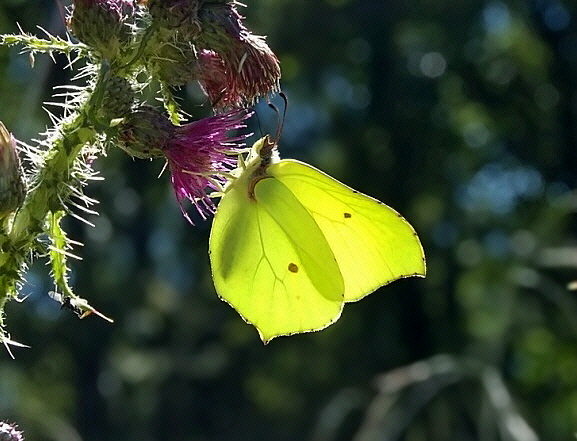
Brimstone Gonepteryx rhamni, male, Noar Hill, Hampshire – Adrian Hoskins
Introduction
According to popular myth, the word ‘butterfly’ may be derived from ‘butter-coloured fly’, a term which may have been applied to the Brimstone by early naturalists. It is one of Britain’s most well known and common species; and often the first species to be seen when the adults awake from hibernation in early Spring.
The Brimstone is a beautiful insect and a grand master of camouflage. The pale greenish underside, raised wing-veins and falcate wing tips combine to disguise the butterfly as a leaf, making it near invisible when at rest under bramble or ivy.
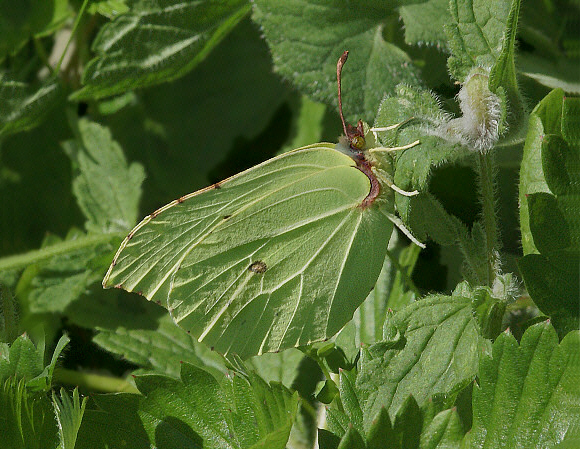 Gonepteryx rhamni, female at rest, Stockbridge Down, Hampshire – Adrian Hoskins
Gonepteryx rhamni, female at rest, Stockbridge Down, Hampshire – Adrian Hoskins
The Brimstone is very widespread and common throughout Europe with the exception of Scotland and northern Scandinavia. Beyond Europe it occurs in Morocco, Algeria and across temperate Asia to western Siberia and Mongolia.
here are 2 other Gonepteryx species in southern Europe – cleopatra, which is deeper yellow, and flushed with orange on the forewings of the male; and farinosa which is almost identical to rhamni except that its wings are a slightly different shape and have a distinctive rough texture. The latter species is found only in Turkey, Greece, Bulgaria, Albania and the Middle East.
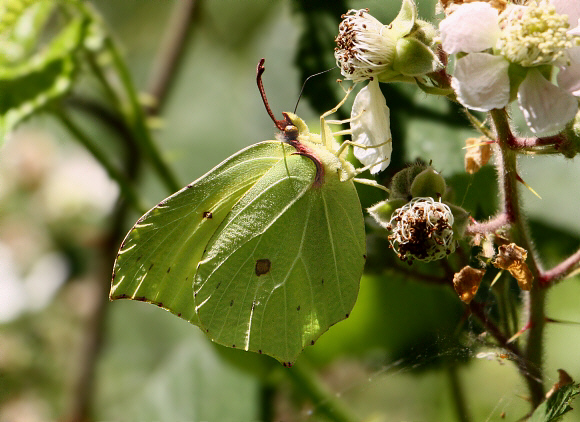 Brimstone Gonepteryx rhamni male, Bentley Wood, Wiltshire – Adrian Hoskins
Brimstone Gonepteryx rhamni male, Bentley Wood, Wiltshire – Adrian Hoskins
Habitats
In Britain the Brimstone is common in the southern half of England and south Wales, but becomes scarcer further north. In Scotland it occurs only as a vagrant.
Whereas most butterflies have very strict habitat requirements and are thus localised in distribution, the Brimstone is highly mobile and can be seen in almost any habitat within its distribution range.A given insect may wander many miles from its emergence site, breeding with insects from other areas. This helps it to maintain a high level of genetic diversity, resulting in a hardy species that is highly adaptable, and not prone to major population fluctuations from year to year.
The Brimstone is commonest on scrubby chalk grasslands and deciduous woodlands but it will breed almost anywhere where its larval foodplants grow, including heathland, farmland, railway cuttings and coastal habitats. It is also regularly seen in gardens and parks or meandering along roadsides when dispersing in search of new habitats.
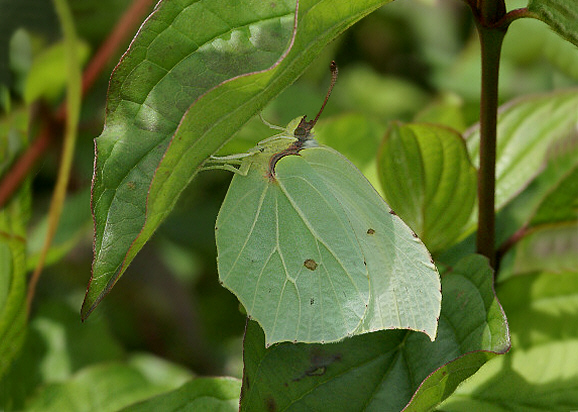 Brimstone Gonepteryx rhamni, female, Stockbridge Down – Adrian Hoskins
Brimstone Gonepteryx rhamni, female, Stockbridge Down – Adrian Hoskins
Lifecycle
The butterflies emerge in late June or early July, and fly until late August or early September when they enter hibernation. During the winter months they sometimes awaken and fly on sunny days, but do not become fully active again until late March or early April. Both sexes remain on the wing until June, sometimes overlapping with the newly emerged summer adults. The Brimstone is the longest-lived species in Europe, with an adult lifespan of up to 11 months.
In April and May the female lays her pale greenish-white skittle-shaped eggs singly on the buds or young leaves of buckthorn bushes, chiefly alder buckthorn Frangula alnus on acid soils such as the New Forest heaths and woodlands; or Rhamnus catharticus on chalk or limestone sites.
The Brimstone will oviposit on almost any buckthorn, regardless of its size or situation – I’ve found eggs on everything from tiny isolated saplings on open heathland to tall bushes in thickets on chalk grassland. In woodland, semi-shaded bushes growing deep in the understorey seem to be used as often as those in sunlight along ride edges. The eggs can be laid at any height on the plant.
The eggs are laid singly but I have found up to 19 on a single leaf, and up to 100 on a single small bush, laid over several days during repeat visits by one or more females. Oviposition takes place over a protracted period – I have seen Brimstones laying on the buds of tiny buckthorns in early April, on developing buds and young leaves in May, and on the leaves of tall bushes in early June.
When small, the larvae feed on the underside of the leaves, peppering them with tiny holes. Older larvae be found resting along the midrib on the upper surface of the leaves, with the front half of their bodies arched. Throughout their development they are green, and covered with a sprinkling of short fine hairs.
Brimstone larvae, like those of all butterflies are prone to diseases, parasitoids and predation. Birds ( especially warblers ) and wasps are the main predators, but I once found a fully grown larva that was being pinned to a leaf by a trio of 4th instar Troilus luridus shield bugs which were tugging at it from various directions as they sucked its body fluids.
When ready to pupate, the larva attaches itself by the tail and a thin silk girdle to the underside of a buckthorn leaf, or sometimes to a narrow stem away from the foodplant. It hangs in this position for about 24 hours during which the body gradually arches and stiffens prior to pupation. The chrysalis is pale green and is superbly camouflaged, but can be found by diligent searching in June and early July. The wing colours of the developing butterfly can be seen about 3- 4 days before emergence. Emergence takes place mid-morning, and the wing-drying process takes about 20 minutes.
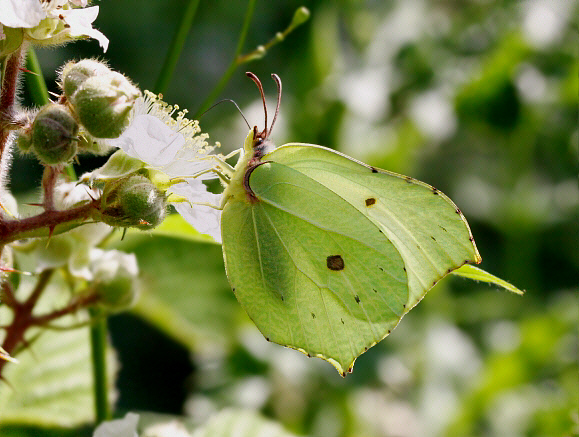
Brimstone Gonepteryx rhamni, female, Bedwyn Brail, Wiltshire – Adrian Hoskins
Adult behaviour
Both sexes emerge together in late June or early July. In the summer they visit woodland flowers including bramble, marsh thistle, spear thistle and burdock. They are also very strongly attracted to teasel, and often 3-4 Brimstones can be found on a single flower head. At grassland sites the most highly favoured nectar source is wild basil, but knapweed, small scabious, devil’s bit scabious, musk thistle, spreading bellflower, hawkbit, ragwort, marjoram and buddleia are also visited.
Brimstones enter hibernation in August or early September. Most entomological books quote ivy as the commonest hibernation site, and indeed over the years I have found several individuals tucked beneath ivy leaves – usually at a height of about 3 metres where ivy densely covers the trunks of old oaks. I have more frequently however found them beneath bramble leaves, usually less than a metre above ground level. I’ve also commonly found them in tussocks of pendulous sedge, where they settle in the angle formed by the drooping leaves.
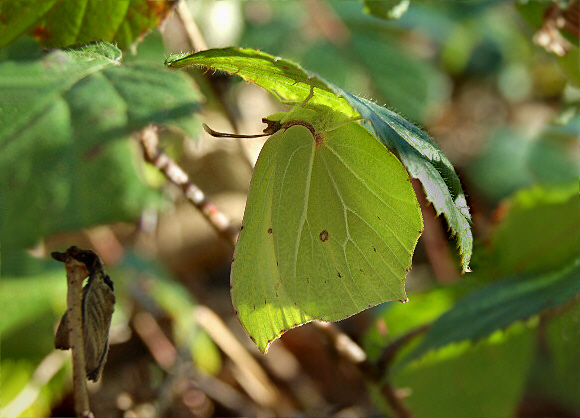
Gonepteryx rhamni, male hibernating under bramble leaf, Stansted Forest – Adrian Hoskins
Males normally awaken from hibernation several days before the females, on the first sunny and warm day of Spring. This is typically in March, but on the morning of 21st February 2009, I counted no less than 19 males in Crab Wood, Hampshire. All were actively searching for females amongst brambles and ivy. Unusually, on 12th January 2008, I saw a female in flight in Stansted Forest – a full month before the appearance of the first males.
In the spring Brimstones nectar at primrose, bugle, bluebell, common violet, blackthorn, dandelion, cowslip, buttercups, daisies, wood anemone, vetches and sallow catkins.
Brimstones are very adept at detecting changes in temperature, humidity and air pressure. At Crab Wood in March 2007, shortly after midday I watched 5 males actively investigating bramble bushes in a sunny glade. At first I thought they were searching for females, but it soon became clear that they were all looking for places to shelter, having detected an imminent change in the weather. One by one they settled under bramble leaves to roost. Minutes later the sunshine disappeared, clouds had rolled in, and rain was beginning to fall.
In spring Brimstones often bask on the ground with their wings closed and canted over to present the maximum area towards the sun. At such times hoverflies Episyrphus and Muscid flies Helina will often settle on their wings, possibly after mistaking the butterfly for a leaf, or perhaps just taking advantage of the heat reflected from its wings.
Courtship takes place on sunny mornings in early spring, and females are probably mated within a few minutes of their first post-hibernation flight, in March or April. If a male intercepts a female that has already mated, she immediately settles and inverts her wings, then raises her abdomen as a rejection signal. At this point, if the female is on the ground, the male will often walk onto her open wings, in which case the female ‘freezes’ with her abdomen pointing vertically upwards to prevent the male from copulating. Males usually persist for several minutes however, and the female often tries to escape by flying deep into herbage in an attempt to lose her unwanted suitor.
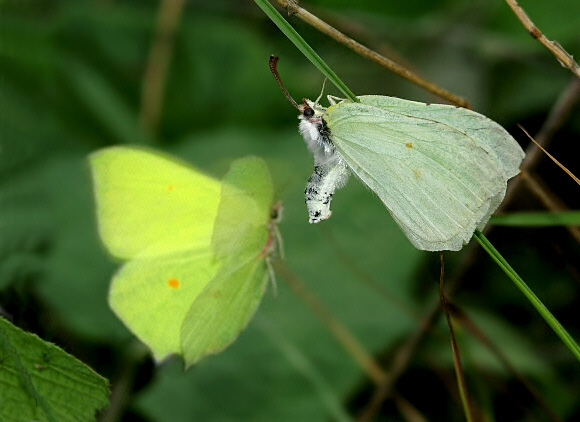
Brimstone, female raising abdomen to signal rejection to male, Hampshire – Adrian Hoskins
When a male intercepts a virgin female, they usually fly a short distance to settle on a nearby bush. The male then attempts to copulate but rarely succeeds at the first attempt. The female commonly responds by escalating rapidly to a height of 10-20 metres, with the male in hot pursuit. Contact is then usually broken, and the pair return separately to ground level. Invariably within 2 or 3 minutes they meet again, and another similar chase takes place. Eventually, if the female is receptive to the males advances she flies to a nearby leaf, either in a bush or among low herbage, settling beneath it with her wings closed. The male is then able to move alongside and copulate. He then adjusts his position until the pair face opposite directions.
It is normal for Brimstones to remain paired for several days, presumably because the metabolic rate is very slow during the cool days of early spring, when frosts and snow commonly occur : On 30th March 2008 I found a copulated pair in Crab Wood, Hampshire. A week later on 5th April they were still in copula beneath the same leaf of dog’s mercury. I recorded an even longer duration in April 1986 when I found a pair of mating Brimstones under a bramble leaf at Tugley Wood in Surrey – a place which I then visited on almost a daily basis. I marked the spot, and revisited the site the following day, finding them still copulated. Out of curiosity I returned several times during the next few days during which the weather remained cool. They remained copulated for an amazing 17 days before finally separating and flying off when warmer weather returned at the end of the month.
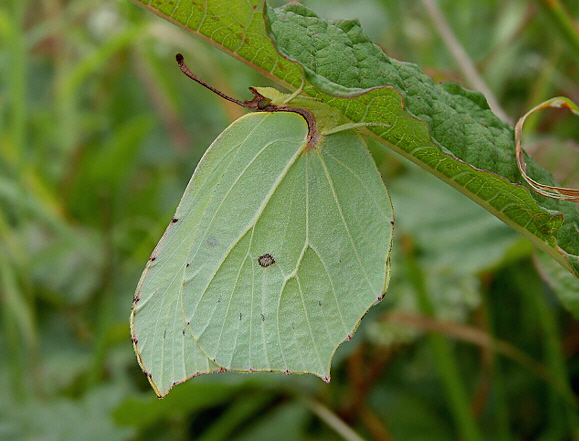
Gonepteryx rhamni, female roosting under dock leaf, Stockbridge Down – Adrian Hoskins
